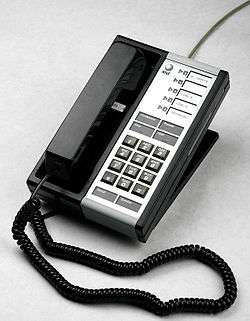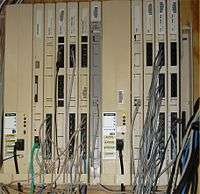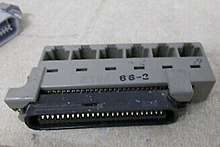AT&T Merlin
AT&T Merlin is a corporate telephone system by American Telephone and Telegraph (AT&T) that was introduced in late 1983, when it was branded American Bell Merlin. After the breakup of AT&T in 1984, it was rebranded and later also supplied by Lucent, and Avaya.

The system was designed at the beginning of the 1980s prior to the Bell System Divestiture as a modern electronic replacement for the dated electromechanical 1A2 Key System. Earlier Bell attempts at an electronic key system, such as Horizon and Dimension, were not as successful as were the much larger systems; in fact, Dimension was a PBX. The Merlin was the first small electronic system, replacing the Com Key 416. The Merlin system was originally sold in two-line, six-telephone (206); four-line, 10-telephone (410); and eight-line, 20-telephone (820) configurations. Later, there was a further 10-line, 30-telephone configuration, with an expansion key service unit (KSU) allowing the system to accommodate up to seventy telephones available (1030 and 3070 respectively).
Predecessors
The 1A2 Key Telephone System and later ComKey series (4-16, 7-18, 14-34) had the following problems which the Merlin system sought to solve with a microprocessor design:
- Complex mechanical line switches in every telephone
- Each individual line pair plus control and lamp pairs must be run to each individual telephone, making for expensive on-premises wiring
- Telephones were connected to one another using labor intensive point to point wiring
- Control units consisted of many separate components including a power supply, line and feature module carrier, and punch blocks
- Compared to more modern designs emerging in the 1970s, manufacturing and maintaining the system became very expensive, especially by the 1980s
- Basic features were present such as line switching, intercom, and hold but there was little possibility for addition of modern features
History
The Merlin system fixed these problems by:
- Having line switching done completely electronically at the control unit (Horizon was the first to do so)
- Using 4-pair wiring (one pair for control signals, two pairs for two independent analog voice paths, and one pair for -48V power and ground). The Horizon system was also the first "skinny cable" key system in the world and was introduced in the late 1970s and like control unit switching provided the foundation of the system employed on Merlin[1]
- An important advance in handset design was the use of printed circuit boards and automated assembly which were economical to produce. Horizon, Dimension and Merlin were leaders in the use of PCB based handsets.
- Fully electronic, all inclusive, one piece control unit
- Slots for feature modules made possible optional extra price features such as Speed Dialing, Automatic Line Selection, and Redial
- The Merlin telephones were also backwards compatible to the higher end enterprise systems, such as then System 75 and System 85 systems, then later Definity system, now called Communication Manager platforms.
The original Merlin was replaced with the Merlin Plus system in the late 1980s, using circuit cards to be expandable to 8 lines and 20 telephones, much like the original 820 model. The original Merlin Plus was dubbed the 820d. It is identical in features to the earlier Merlin, the 820, with the Feature Package 2 cartridge installed. Following the 820d was the 820d2. The 820d2 included the previous features as the 820d but featured an Automatic System Access (ASA) processor coupled with a voice synthesis capabilities and a Busy Buster. The ASA processor provided users with call forwarding, direct extension dial, and system answer capabilities. The busy buster allowed users to have the 820d2 automatically retry a busy number every minute for up to 10 minutes and notify the user when the call was connected. Both the ASA and Busy Buster required a their own voice terminal port to function. In the early 1990s, the Merlin II and Merlin Legend debuted with even more features and expandability, and new MLX telephones, but the system was also backwards compatible with the original Merlin telephones.

In 1999, Lucent Technologies introduced the Merlin Magix as the replacement for the Merlin Legend. The Magix's carrier was metal and, as such, modules were not encased inside plastic shells as they were with the Legend. The Merlin Magix supports new 4400 series digital telephones as well as older MLX telephones, but it does not support the old ATL series telephones. One important item with the conversion of Legend to Magix, is how MLX telephones use 2-pair wiring and the newer Magix/4400 series phones only use a single (1) pair. This made the Magix easier to install and more competitive in the marketplace, as most other digital PBX systems only use a single (1) pair to each station/telephone.
Due to declining sales and the introduction of the IP Office product line, Avaya retired the Magix on April 1, 2006.
Despite being over two decades old, the Merlin's modern electronic features and legendary Bell System era quality and durability still make the classic Merlins very popular telephone systems with small businesses. Merlin sets shared over 50 pieces of plastic with digital telephones of the Dimension PBX as well as membrane switch technology (a first use in AT&T), reducing product introduction costs in 1983.
Popularity and cultural significance
Of all the Merlin telephones, the original phones using membrane button technology were possibly the most elegant. Membrane buttons were a radical design choice for its time while other manufacturers used fixed, raised button keys to select lines and features.
In the late 1980s and early 1990s, the Merlin phones were considered modern, sleek, and ownership was considered as fashionable as a Rolex watch. Because of their relatively high cost, the Merlin phones made a social status statement as something only the most trustworthy, successful businesses could afford. Part of that popularity may be attributed to significant product placement in movies and television [2].
Although the competition was increasing for new choices of customer-owned, on-premises business phone system solutions after the Bell divestiture, the AT&T Merlin distinguished itself from its less expensive alternatives through fashionable design and extensive marketing efforts. [3].
The Merlin system created an entirely new idea that business technology could reflect interior design and business aesthetics. Steve Jobs of Apple, Inc. was often photographed with an AT&T Merlin phone in his office [4], he has suggested he admired was inspired by AT&T design [5], and insisted the AT&T network as first provider on which to release the first Apple iPhone.
"Skinny cable" revolution
The 1A2 phone system was the only multi-line telephone system solution for many decades, but it also had feature limitations, complex cable management, and high maintenance cost. Each 1A2 multi-line telephone required at least a 25-pair Category 3 cable necessary for line access and button/light controls, with some receptionist telephones requiring a 50-pair or 100-pair connection for one attendant console.


The Merlin system (and its predecessor the AT&T Horizon system) was designed to eliminate the complexities of 1A2, including the difficult and expensive 25-pair cable. Engineers were able to utilize electronic switching in the control unit (KSU) instead of switching in the phone itself so all the Merlin system telephones were more like mainframe dumb terminals (AT&T actually called them voice terminals instead of “phones”), reducing telephone cost and simplifying troubleshooting.
The Merlin system introduced a new wiring design of eight wires (four-pair) that allowed the system to deliver two voice paths to each desk phone so a user on an active telephone call could still receive a paging announcement on their phone’s desk speaker simultaneously. AT&T described the signaling channel on the data pair as “analog multi-line telephone protocol (40 kbps)” but no further details were made available about the protocol.[6]
Attached here is the pin-out diagram of the new "skinny cable", only requiring 4-pair Category 3 cable, to each telephone set while providing the same multiline functionality of 1A2 and more. It uses the RJ45 connector to connect each phone (voice terminal) to its associated extension jack on the Merlin control unit (KSU).
For sites with previously installed 1A2 systems, an adapter was available that could simply be connected to the Amphenol connector commonly used by 1A2 telephones. It would convert one 1A2 phone extension's connection cable to up to six RJ45 connections for AT&T Merlin phone extensions without the need for rewiring.
Merlin 206, 410, 820 cartridge information
Cartridge Type I
Feature Package 1 (Available for use in Classic Merlin 206, 410 only):
- 5-party conference calling
- Ringer options
- Prevents outgoing calls on individual phones
- Privacy
- Automatic outside and intercom dialing
- Last number redial, automatic line selection, do-not-disturb
- On-hook dialing, call transfer, hold reminder, group listening
Feature Package II (Included same features as Feature Package I plus the following)
- Personal and system wide 3 digit speed dialing
- Personalized Ringing
- Call pickup
- Group paging zones
Cartridge Type II
Music On Hold
- Allows a music source to be connected to the KSU which is heard by a caller on hold
Music On Hold/Paging
- Allows a music source to be connected to the KSU which is heard by a caller on hold
- Provides a paging system connection and music on hold to be used as background music while no pages are being made.
Cartridge Type III
Power Failure/Extra Alert
- Provides two RJ-11 jacks for standard touch-tone or rotary phone use in case of power failure.
- Extra Alert jack for external notification device.
Merlin device add-on accessories
Data Collector
Used only with the Merlin Plus system for logging calls or configuration to a printer. The Merlin Plus system Data Collector uses information from the Call Report and System Feature Report features and transmits the material from the Merlin Plus system to a printer or to a PC with a standard RS232-C, 1200 baud, serial interface. You can connect the data collector to an available voice terminal jack on the control unit.
The data collector can hold up to one full page of printout, 60 lines of 80 characters each. The collector disregards any material over the one page limit.
The Merlin Plus system is set to have the data collector and the printer connected to voice terminal jack 19, but the administrator can connect the data collector and the printer to any other voice terminal jack in the system, except jack 10.
Door phone controller (DAC-1Z)
A door phone controller (DAC-1Z) can be connected to your Merlin Plus system to allow employees to answer calls made from a business entrance.
It is connected directly to a CO line port on the Merlin Plus control unit. Callers using the door phone can press a button at the building entrance to ring a telephone in your Merlin Plus system. An auxiliary alert device (such as a doorbell, chime, or tone generator) can be connected to the door phone controller so that it will ring when the door phone button is pushed.
An optional electric strike plate release can be obtained for door operation to permit the caller to unlock the door by entering a preset code on the door phone keypad. The electric strike plate can also provide an alarm that sounds when the door is opened by unauthorized means or is not closed within a certain amount of time.
Although the door phone controller can be configured to connect to either a Central Office (CO) port or a station port, it is recommended that only the CO port connection be used. The CO port to which the door phone controller is connected can be dedicated to the door phone controller, or shared by a CO line and the door phone controller.
References
- https://themuseumoftelephony.wordpress.com/tag/horizon-pbx/
- https://productplacementblog.com/tag/att/
- https://books.google.com/books?id=W2XQnES_RBoC&lpg=PA68&ots=XDDvzwnQbZ&dq=AT%26T%20business%20phone%20system%20sales%20over%20the%20decades%20report&pg=PA68#v=onepage&q=AT&T%20business%20phone%20system%20sales%20over%20the%20decades%20report&f=false
- https://in.pinterest.com/pin/289848926013754975/
- https://www.whipsaw.com/thinking/my-four-insanely-great-experiences-with-steve-jobs/
- Overview Merlin Phone Systems v5
- AT&T Sourcebook Catalog 1992, 1993, 1995.
- Merlin Installation, Programming & User Guides MERLIN 410: All Documents
- eOpinions.com on the Merlin Magix discontinuation
- Definity Enterprise Communications Server and System 75 and System 85 Terminals and Adjuncts Reference Manual December 1999, support.avaya.com
- Overview Merlin Phone Systems v5
- AT&T Merlin Plus Installation Manual 1987.
